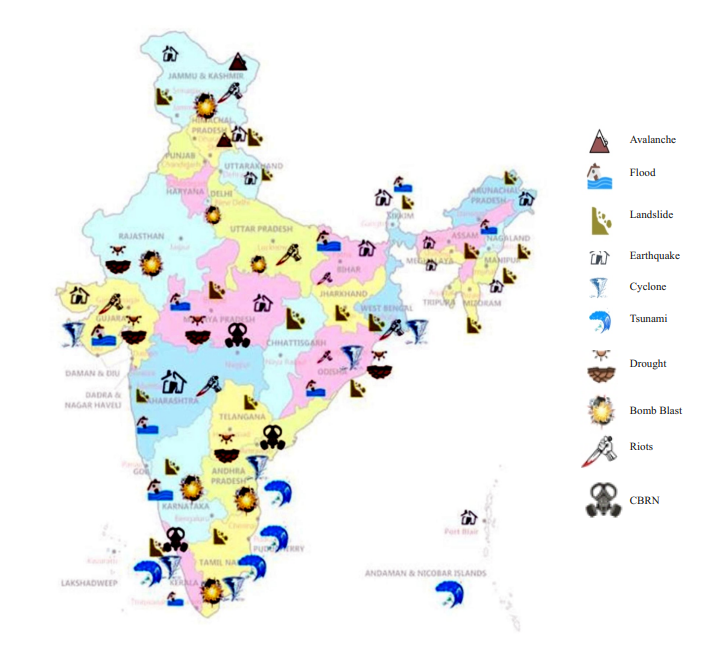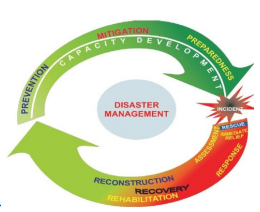Introduction to Disaster
Introduction to Disaster
Disaster is an event or hazard that threatens the safety and lives of the people and is often unforeseen. It causes a severe ecological and psychosocial disruption that exceeds the coping ability of the affected people/community.
United Nations Office for Disaster Risk Reduction (UNDRR), defined disaster as “A serious disruption of the functioning of a community or a society at any scale due to hazardous events interacting with conditions of exposure, vulnerability and capacity, leading to one or more of the following: human, material, economic and environmental losses and impacts".
The Disaster Management Act (DMA) (2005) states, disaster as “a catastrophe, mishap, calamity or grave occurrence in any area, arising from natural or manmade causes, or by accident or negligence which results in substantial loss of life or human suffering or damage to, and destruction of, property, or damage to, or degradation of, environment, and is of such a nature or magnitude as to be beyond the coping capacity of the community of the affected area”.
Types of Disasters
Disasters can be broadly classified as natural and human-made disasters. The severity of the impact, amount of damage and the nature of support required for the affected people indicate if the emergency is a disaster. For example, an earthquake that happens in a desert cannot be termed a disaster as it occurs in a place where people do not live.
Natural Disaster: Occur as a result of natural physical phenomena either by rapid or slow onset of natural events (Below Table).
Human-induced Disaster: Are events that occur as a result of human actions and settlements. For instance, pollution, environmental degradation, negligence, etc.
| Natural Disasters | ||
| Nature | Cause | Type |
| Geophysical disasters | Geological disturbance | Earthquake, Tsunami, Avalanche, Landslide, Volcano, Mass movement (dry), Rock-fall, Subsidence |
| Meteorological or Climatological disasters | Extreme Weather | Storm, Heat/Cold Wave, Drought, Forest Fire, Land Fire, Wildfire, Tropical cyclone, Extra-tropical cyclone, Local storm, Climatological, Extreme temperature, Extreme winter condition |
| Hydrological disasters | Flooding or movement of water bodies | Flood, General flood, Storm surge/coastal flood, Mass movement (wet), Rock-fall, Landslide, Avalanche, Subsidence |
| Biological disasters | Microorganisms | Pandemic, Epidemic, Insect infestation, Viral infections, Disease, Bacterial infectious Disease, Parasitic infectious disease, Fungal infectious disease, Prion infectious disease, Insect infestation, Animal stampede |
| Human-made Disasters | ||
| Industrial accidents | Industrial or infrastructural damage or accidents | Chemical Spill, Explosion, Gas leak, Poisoning, Radiation |
| Communal accidents/Sabotage | Impatience of humans impacting the safety of other people or destruction of property | Riots, Terrorist Attacks, Bomb Blasts, Stampede |
| Accidents caused by human negligence | Accidents caused by human negligence | Air/Train/Road/Water accidents, Fire Accidents, Building collapse |
Common Disasters in India
Disaster is not a new phenomenon. Disasters have been taking place worldwide constantly with “varied degrees of severity”. Due to the geo-climatic conditions and socio-economic vulnerability India is highly prone to different types of disasters. India is said to be one of the ten worst disaster-prone countries in the world. 30 different types of disasters, including drought, floods, cyclones, landslides, soil erosions, earthquakes have affected Indian communities (NDMA, 2016).

Disaster Management Cycle
 Disaster management (DM) as defined in DMA, 2005 is “a continuous and integrated process of planning, organising, coordinating and implementing measures which are necessary or expedient" for the following:
Disaster management (DM) as defined in DMA, 2005 is “a continuous and integrated process of planning, organising, coordinating and implementing measures which are necessary or expedient" for the following:
- Prevention of danger or threat of any disaster.
- Mitigation or reduction of risk of any disaster or its severity or consequences.
- Capacity-building.
- Preparedness to deal with any disaster.
- Prompt response to any threatening disaster situation or disaster.
- Assessing the severity or magnitude of effects of any disaster.
- Evacuation, rescue, and relief.
- Rehabilitation and reconstruction
Stages of Disaster Management Cycle
Response/Rescue : This is initiated immediately after a calamity to ensure that everyone is safe. It involves providing temporary shelter, food, drinking water, other basic essentials, clearance of carcass (dead bodies), easing access to health care facilities, maintaining sanitation, power supplies, public information, and security. It has to be initiated within 72 hours from the impact.
Relief : It aims at providing humanitarian help and recovery from the impact of disaster based on the psychosocial needs of the affected community. Along with other relief measures psychosocial support and mental health services will be provided at this stage. It has to be initiated between 72 hours to three months.
Rehabilitation : It involves all measures aiming at increasing resilience, strengthening livelihood, quality of life and day-to-day activities. It focuses on enabling civic utilities, building infrastructure and restoration. From the mental health service point of view, it should aim at monitoring psychosocial complications, and facilitating mental health referrals and follow-ups. It runs between three months to two years.
Reconstruction/Rebuilding : This stage goes on between two years to lifetime. It aims at creating sustainable and resilient communities that help to rebuild the individual coping abilities, family structures, livelihood, and environment. This stage is also linked with the pre-disaster phases (preparedness and mitigation) where the community is prepared to respond better to future emergencies.
Mitigation : It is a process focusing on the elimination/reduction of disaster impact. This includes planning or modification of plans/policies, and developing measures to reduce disaster risk from local to national level.
Preparedness : It is an ongoing activity where individuals, families and communities are helped to plan activities that they can do in response to a disaster and to minimise the impact of disaster. This ensures promptness, fosters adaptation, and builds resilience.
Last Modified : 11/23/2023
Disaster is a natural or human-made event. It caus...
Psychosocial First Aid (PSFA) is an immediate inte...
Psychosocial triage is a systematic assessment and...
Psychosocial First Aid (PFA) helps people in need ...
